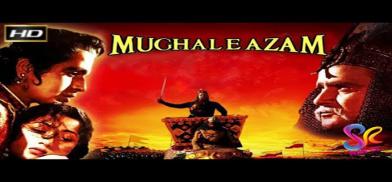Once seen as 'common heritage', Mughal-e-Azam's 60th anniversary goes unnoticed in Pakistan
Those who follow Bollywood, anywhere in the world, are taking note of the iconic Mughal-e-Azam, which completed 60 years this month, as its screenplay, written by four veterans of that golden age of the Hindi film industry enters the official Oscars library

Those who follow Bollywood, anywhere in the world, are taking note of the iconic Mughal-e-Azam, which completed 60 years this month, as its screenplay, written by four veterans of that golden age of the Hindi film industry enters the official Oscars library. But the anniversary did not evoke much interest in Pakistan.
It is surprising, and also ironic. Mughal-e-Azam ought to have stirred interest considering that at least two of its leading lights, late Prithviraj Kapoor, who played Mughal emperor Akbar, and Dilip Kumar, who was his rebellious son, Prince Salim, were from the same area in Peshawar. The film is in Urdu, Pakistan's national language.
Mughal-e-Azam in Pakistan
Released on August 5, 1960, to rave reception at home and abroad, Mughal-e-Azam is rated as one of the greatest films made in India. But it took 41 years to cross the border. What is notable is that Mughal-e-Azam was the first film in 41 years to break the ban of Bollywood film release in Pakistan.
Surprisingly, even that recall is now missing in the Pakistani media and its world of entertainment.
Mughal-e-Azam was released in Karachi’s Gulistan cinema on April 26, 2006 – and this too has an interesting story worth recalling after a good 14 years.
The release of the film came about when rapprochement was building up, led by Indian Prime Minister Manmohan Singh and Pakistan’s military ruler, President Pervez Musharraf. Working through back channels and ‘thinking out-of-the-box’,Noo as Musharraf once said, both the leaders worked out a political and diplomatic détente and ‘cooling’ of the contentious border issues. It did not succeed, mainly because of Pakistan’s internal turmoil leading to Musharraf’s ouster. But that did not impact the presence of Bollywood in Pakistan. In fact, Bollywood movies were allowed regular screenings in theatre halls. Though from time to time ban on the screening Indian movies have been imposed in Pakistan whenever relations with India have been strained.
The 2006 release in Pakistan was actually a ‘battle’ between three Akbars - one played by Prithviraj in the movie, Akbar Asif, son of the legendary Karim Asif, who had directed the iconic film, and Akbar Khan (brother of actor-filmmaker Firoz Khan and Sanjay Khan), who was keen to premiere his movie Taj Mahal: An Eternal Love Story. Akbar Khan’s movie was based on Emperor Shahjehan, Queen Mumtaz Mahal, and the monument of love. In Mumtaz’s role, Khan had launched Sonya Jehan, granddaughter of the legendary Pakistani actress-singer Noor Jehan.
Reports of that time indicate that London-based Akbar Asif had his way and Mughal-e-Azam was released before Akbar Khan’s film. In a manner of speaking, the grandfather (Akbar) had taken precedence over grandson (Shahjehan).
Nadeem Mandviwalla, head of Mandviwalla Entertainment, the official distributors of the film in Pakistan, said: "The showing of Mughal-e-Azam in Pakistan, is historically, no less significant than the film itself.
"It is an opportunity for, and is the best catalyst, for the revival of cinema in Pakistan, at the same time cementing the relationship between India and Pakistan."
'Common heritage'
Akbar Asif launched the film in style with a trailer that ran for a record seven minutes and 36 seconds. At the film’s Karachi premier, an ornate arch was erected to match the film’s grandeur and top artists enacted the grand entry of the emperor with his queen, Jodhabai.
Pakistan’s official stamp came with the presence of Ziauddin Khattak, then chairperson of the Central Board of Film Censors. He said: "Mughal-e-Azam is a reflection of the common heritage our two nations have".
Khattak said any profits from the movie would be donated to charitable causes in Pakistan.
Also present was Saad Shiraz, son of Shiraz Ali Hakim, the original director of the film till 1944 when K. Asif took over, and Naeem Tahir, son-in-law of Imtiaz Ali Taj whose theatrical rendition of Anarkali was the inspiration for Asif. A short clip of the worldwide launch of Mughal-e-Azam was also shown.
The original film was in black and white, save the memorable song and dance sequence ‘Pyar Kiya Toh Darna Kya” featuring a defiant Anarkali, a courtesan in love with Prince Salim, played by yesteryear screen goddess, Madhubala. The film was digitally restored and converted in colour, an achievement of Indian technology, in time for the Pakistan release. This colour version became the first Indian movie to be released in Pakistan after Indian movies were banned thereafter in the 1965 war.
Grand revival
Deepesh Salgia of Sterling Investment Corp India, project director for the restoration of Mughal-e-Azam, explained some of the technical details involved in digitising and re-mastering the film. He said the team opted for specialised software developed in India to enhance the 300,000 frames of movie time, over commercially available, off-the-shelf software such as Adobe. The research for the project took almost a year and a half while the process of restoration spanned 13 months.
The August 2006 release in Pakistan was, of course, official. No imports of Indian films had taken place after the 1965 war. Over that long period, many Indian films were plagiarized since the original ones - save the pirated prints via Dubai - were unavailable.
Before the 1965 conflict, Indians and Pakistanis could cross the Wagah border (the only road crossing from India into Pakistan) and visit each other. Old records show people from Lahore would come to Amritsar via the Wagah border that connects Punjab, to watch the movie and return home by the evening.
The Zia-ul Haq era saw large-scale plagiarizing of Bollywood films, with more sex and violence added. A leading light of these ventures was Shameem Ara, herself a top Lollywood (Pakistan's Lahore-based film industry) actress, who turned producer and director, who churned out “cheap imitations of Bollywood that left nothing to the imagination,” Andrew Rippin wrote in his book The Islamic World (page 541, published in 2013).
The continued India-Pakistan strife, ban of Pakistani actors in Bollywood, followed by COVID-19 restrictions have led to cinema halls facing an uncertain future in Pakistan. Indian movies have always drawn big crowds to theatres. But films are now being seen on the digital platforms across the border, making a formal release redundant.
So it has come as a surprise that the news about Mughal-e-Azam’s screenplay (three versions - in Hindi, Roman text and English translation) now being available at the prestigious Margaret Herrick Library, the main repository of the Academy of Motion Pictures, Arts and Science, was missing from Pakistani media.
More so as the anniversary underscores the historic significance of an event that helped in enriching the cultural exchange between the two neighbours who share a common culture and heritage.
(The writer is President, Commonwealth Journalists Association (CJA). He can be contacted at mahendraved07@gmail.com)










Post a Comment